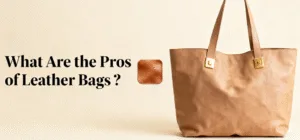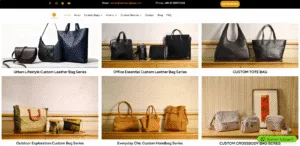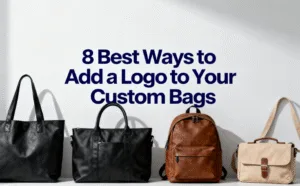Screen printing and embroidery are two common choices that custom tote bags with a logo for business. Embroidery offers neat, professional stitches that enhance the overall look—but appearance isn’t the only consideration. It’s also important to think about how well the design will hold up over time. Durability varies with usage, so the choice of bag material plays a key role as well.
Contents
Process and Technique of Customized Bags With Logo

Screen-printed tote bags from a reliable bag manufacturer are a good way to customize bags with logos. However, their processes and techniques are quite different.
Screen Printing Process
Screen printing offers a clean, modern look, making it ideal for current brands. At a tech conference, bags with screen-printed gradient logos were very popular. About 78% of attendees preferred these bags over older styles, and they sold quickly off the display table. The smooth ink creates a polished surface that enhances bright designs, especially on light-colored materials, where the colors really stand out. As noted by Pantone Color Institute, screen printing remains one of the most effective ways to deliver bold, consistent color in branding applications—especially when vibrant hues are essential to a brand’s identity.

| Step | Details |
|---|---|
| Materials Setup |
For canvas bags, ensure they are clean, flat, and have no wrinkles. Tools include mesh screens, special ink, squeegees, and emulsions. |
| Design Preparation |
Create a stencil of the design. Print the design onto a clear sheet to make the stencil. |
| Screen Preparation |
Coat the mesh screen with a light-sensitive emulsion. Expose the screen with the design to a light source, hardening the emulsion in the design areas. The unexposed emulsion washes away. |
| Printing Process |
Carefully line up the screen on the tote bag. Let the ink air-dry or use heat to set it, ensuring the print lasts longer. |
| Advantages |
Cheaper for large orders. Works very well on cotton or custom canvas bags. Designs come out bright and strong. |
| Limitations |
Not ideal for complex designs with many colors. Preparation steps before printing can take some time. |
Design and Details of Embroidery Printing Process

Before starting embroidery, special software is used to turn the client’s logo into a DST file, a step known as digitization. The stitch direction, thread color changes, and stitch density are carefully planned to avoid fabric bunching from excessive stitches, ensuring the right balance. A digital preview is then created for client approval. Once approved, the bag is prepared with a stabilizer to keep the fabric in place and ensure a clean design. The embroidery machine then stitches the logo onto the bag, bringing the design to life with colorful threads. Bright logos on dark fabric especially stand out.
Clients are informed about the extra cost for digitizing the design initially, but this saves time for future orders. Embroidery works best for simple designs and may not be suitable for very small details or smooth color gradients, for which printing is recommended.
Understanding the design limits of embroidery helps meet branding goals. It gives a unique feel, turning simple bags into high-end items that represent a brand well. For example, embroidered laptop bags made for a financial firm last year led to clients frequently touching the raised logo without thinking, creating a tactile experience that flat printing cannot provide. Embroidery adds depth and looks stunning on dark fabrics, as the threads catch the light and create soft shadows.
Material Compatibility
Embroidery Cautions: Be careful with embroidery on thin fabrics like silk. Lightweight fabrics are used in a custom travel bag. This includes materials like cotton blends and polyester.
Screen Printing Benefits: You usually get a cleaner look on delicate fabrics with screen printing.
Application Examples
Luxury Corporate Gifting: For high-end corporate gifts, embroidered logos look great. The raised stitching gives a high-quality feel to your brand image.
Event Giveaway Bags: For event giveaway bags customized with a logo, screen printing is a smart option. It offers strong visual impact with bright, eye-catching designs, and is cost-effective when producing large quantities—making it ideal for conferences, festivals, or promotional campaigns.
Embroidery vs Screen Printing: Custom Bags Durability

Durability is very important when you choose between screen printing and embroidery for your branded bags. Let me explain how each method holds up over time.
Embroidery Durability for Customized Bags With Logo
Built to Last: Embroidery offers great strength. The sewn-in threads become a solid part of the fabric.
Stands Up to Washing and Weather: About embroidered logos keep looking good even with: Frequent washing/Industrial cleaning/Everyday use and wear
Great For: embroidery for work uniforms, sports team bags, and items used a lot, like backpacks and duffel bags.
Screen Printing Durability from Custom Bags Supplier

Starts Strong: Screen printing puts thick ink onto the fabric. The ink is cured, which gives it good strength at the beginning.
Issues Over Time: However, screen-printed designs may start to show signs of wear. With frequent washing, they can gradually fade, and if the tote is folded repeatedly in the same spot, the print might crack. Additionally, with heavy use and exposure to the elements, peeling can occur, affecting the overall appearance of the design.
How to Care for It: To preserve the screen print, it’s important to handle the tote with care. Avoid washing it in very hot water and never iron directly on the printed area. Gently handling the item will also help ensure the design lasts longer.
Good For: Screen printing is a better fit for casual bags or promotional items that you expect people won’t use for a very long time.
Screen Print Vs. Embroidery: Which Material Works Best?

Embroidery Works Well On: Embroidery looks best on strong, structured materials. Last year, embroidered laptop bags were made for a financial firm, and the raised stitching on the thick canvas created a texture that clients couldn’t resist touching. The same effect can be seen on sturdy denim totes, where the threads sink into the fabric, creating a 3D brand look that really stands out. Backpacks, with their firm structure, make an excellent base for embroidery. About 85% of corporate clients prefer this technique for backpacks. The threads catch the light in a striking way, creating small shadows that flat printing cannot replicate.
Screen Printing Works Well On: In contrast, screen printing works well across lighter, smoother fabrics. We recently screen-printed gradient logos on lightweight polyester drawstring bags for a tech conference. They disappeared quickly! The smooth ink application resulted in crisp, colorful images that attendees eagerly grabbed. The ink goes smoothly onto flexible materials. It bends and moves with the fabric without cracking. Unlike the raised feel of embroidery, screen printing is more understated. This makes it suitable for materials that need to remain soft and fold without trouble.
Real-life Examples of How Long They Last custom supplier of tote bags
For instance, based on my observations as a custom supplier of tote bags, an embroidered company logo on a canvas messenger bag can maintain a professional appearance for years, even with daily commuting. The threads remain intact, the stitching holds up, and the bag often develops a charming, worn-in look that adds character without compromising brand visibility.
On the other hand, a screen-printed design on a promotional tote bag might begin to fade or crack with frequent use—especially if the bag is made from thinner materials or exposed to harsh washing conditions. In one case, a client who ordered budget-friendly totes for a short-term campaign found the bags served their purpose well for three to six months, but the prints noticeably deteriorated after that.
These real-world insights highlight how material quality and decoration methods directly affect the lifespan of tote bags. Whether you’re designing a durable tote bag with zipper for professional use or a casual male tote bag for retail, choosing the right construction method through an experienced custom supplier of tote bags can make all the difference in long-term satisfaction and brand impact.
Turnaround Time for Custom Bag

Need customized bags with a logo? Let’s explore the production timelines for screen printing and embroidery. Understanding these timeframes is key to planning effective marketing campaigns—especially when working with event dates or product launches.
Screen Printing Timeframes
Standard Production: screen printing for large orders if you need them fast. Its bulk process is efficient.
Quick Turnaround: You can get simple designs done in just 2-3 days.
Color Considerations: My experience shows that each color needs a separate screen. This adds more time to production.
Volume Efficiency: Screen printing works best for bulk orders. Suppliers often set minimums between 5 and 100 items.
Bulk Example: Need 100 bags with simple designs? You could get them in under a week if the screens are ready ahead of time.
It’s clear that embroidery requires careful preparation. Many clients don’t realize the amount of work involved before the sewing even begins. The first step is converting logos into special DST files that the embroidery machines can read. This conversion process typically takes 24 to 48 hours on its own. Recently, I worked with a startup on their first corporate gift order. They were surprised by the three edits needed for their simple logo. These adjustments were crucial to ensure the threads could produce the right gradient color effect. Standard projects usually take 5 to 7 business days after design approval. However, more complex designs or those with many thread colors can take up to 10 days. About 63% of my clients see better results when they plan ahead. Rush orders typically cost 30-45% more, and rushing often compromises quality. The embroidery machine requires time to stitch accurately, and it cannot be rushed. Achieving great embroidery results takes patience, much like crafting fine wine.
Rush and Expedited Options
Same-Day Services: Need custom bags with logo very fast? Some providers, like Same Day Rush Printing, offer embroidery in just hours.
Rush Fee Structure: Expect extra fees for faster production, as most custom embroidery services charge for rush orders. It’s important to factor this cost in during planning, especially when working with tight deadlines or coordinating larger campaigns. This helps avoid surprises and ensures both timing and budget stay on track.
Deadline Flexibility: Rush options can shorten the usual wait time. You might get your bags in 1-3 days for urgent projects. And this is helpful for tight deadlines.
Emergency Solutions: These rush services are great for last-minute needs. Think events, trade shows, or promotions needing quick branded bags.
Planning your custom bag order? I suggest you think about your deadline, order size, and design details. This helps you choose the best method for your timing.
Summary
Choosing screen printing or embroidery depends on your business needs, but it’s wise to weigh your budget and timeline carefully. Screen printing is often faster and more cost-effective for large quantities, while embroidery offers a premium look and greater durability, ideal for long-term use or high-end branding. Sunteam bag wholesaler has more than 30 years of experience in bag making, specializing in custom logo bags with a low minimum order quantity and a short delivery time.
In addition, consider the complexity of the design and the brand image you want to present. Now we provide free proofing service, submit your design draft, and our expert custom bag team will serve you within 24 hours.






